

![]()
From 1970 to 2009, ship strikes accounted for 44% of known North Atlantic right whale deaths and entanglement in fishing gear accounted for 35% of deaths. The numbers have recently reversed with entanglements in fishing gear accounting for 85% of known deaths from 2010-2015.1 A recent study also showed that 83% of North Atlantic right whales bear scars from entanglement in fishing gear, rising from 57% in 1990, 61.5% in 1995 and 72.6% in 2004.2 The study also showed that 26% of the whales had new entanglements every year and that 59% of the population has been entangled more than once. As for the source of the fishing gear, researchers stated 'rope that has been retrieved from entangled right whales and humpbacks along the east coast of the USA and Canada has been found to come from non-mobile fisheries such as lobster3 and gillnet gear4 in 80% of the cases. The remaining 20% of the cases carried rope that was not identifiable as to source.'5
The exact causes of death for whales entangled in rope and fishing gear are awful and include starvation, systemic infection, drowning, hemorrhage and severe tissue damage.6 The same study that documented this also stated that it takes an average of nearly six months for a whale to die from entanglement in fishing gear.7
One memorable case that demonstrates how bad these entanglements can be is that of a young North Atlantic right whale named Bayla. The article Chasing Bayla that was published by the Boston Globe is really a must-read for anyone interested in finding out more about the struggles these whales face. That article inspired us to learn even more about what was being done to these whales and was the catalyst for this project. The next paragraphs can be read at any time but we highly recommend reading Chasing Bayla beforehand. (Note: There are some North Atlantic right whale sounds that automatically play in the background when the article loads - make sure to check your volume).
There are highly trained and experienced teams like the Marine Animal Entanglement Response team at the Center for Coastal Studies (CCS) that do the extremely difficult work of disentangling whales. Unfortunately that can only be done when a whale is found with an entanglement and the conditions are right for removal.8 As the CCS stated about Bayla (NEAQ Catalog #3911), "Prior to her entanglement sighting, the last known record of #3911 was in February, 2010. During the intervening time she had become entangled, had seriously declined and had apparently been seen or reported by no one. This is a testament to the size of the ocean versus our relatively meager ability to survey that area for whales."9 Disentanglement efforts remain a crucial part of preventing suffering and have certainly saved the lives of many whales but even with some of the top whale experts in the world working to free them from entanglements there are still many that cannot be saved. If you ever see an entangled whale this helpful guide from the Center for Coastal Studies has great information on what to do.
There are other cases such as that of Snowball (Catalog #1131), a whale formerly available for sponsorship through the New England Aquarium (NEAQ), who was last seen in June of 2014 with a severe entanglement and in extremely poor health. According to the NEAQ, Snowball 'has almost certainly died since his June 2014 sighting—having slowly succumbed to infection or starvation, or both. His emaciated body would likely not have floated, sinking to the bottom of the ocean and leaving no chance of someone reporting his carcass.'10
Snowball was first sighted in 1979, making him one of the older males in the population and means he was at least 35 years old when he was seen in such bad shape. He was reported as an 'active entanglement' in the 201411 and 201512 North Atlantic Right Whale Consortium Report Cards but was never officially marked as having died in any of the report cards.
There are most certainly many other whales that have died from entanglements but were not able to be added to the list of deaths because, like Snowball, they were not actually seen dead and were unable to be recovered for a necropsy. This is why we use the phrase 'known right whale deaths' throughout our website as some are seen in very bad shape and are not seen again. We understand that whales like Snowball can't be officially listed as dead in those reports but we feel it is our responsibility to bring his story to you to make sure that his struggle and almost certain death is never forgotten and remains in our minds as we make decisions about how we can avoid contributing to the deaths of these whales.
Snowball entangled in fishing gear in 2014, this was the last time he was ever seen
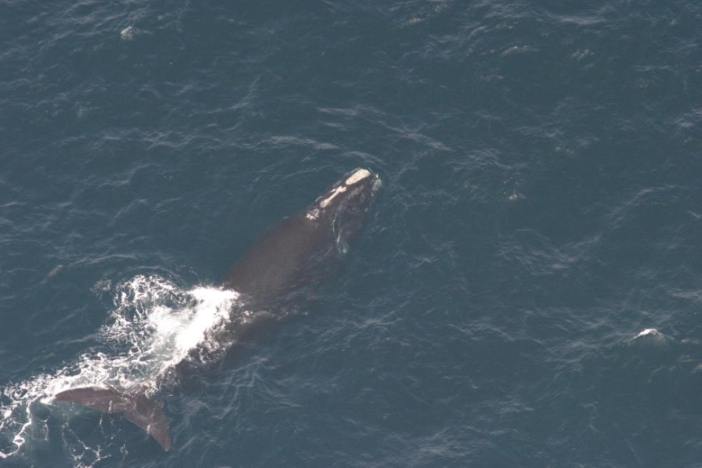
Snowball in 2010, healthy and at a proper weight
Photo credit: Northeast Fisheries Science Center
"The progression to death due to entanglement, particularly when it involves severe gear-induced tissue damage, is likely to be slow and painful. Therefore, from a welfare perspective, lethal entanglements of baleen whales are, arguably, one of the worst forms of human-caused mortality in any wild animal."
- 'Lethal entanglement in baleen whales' study13
In 2016 the Center for Coastal Studies disentangled thirteen whales (ten humpback whales, two finback whales and one North Atlantic right whale)1415 and in recent years there have been multiple reports per year of North Atlantic right whales with new, and sometimes long-term, entanglements. Ten new cases were reported in 2017 alone, half of them in US waters and half in Canadian waters.16
One whale with a long-term entanglement is a whale named Kingfisher (Catalog #3346) who was first seen entangled in 2004, a year after he was born. A team from the National Oceanic and Atmospheric Administration (NOAA) removed some rope and gear from him back in 2004 but as stated in a press release, "poor weather conditions and the movement of the whale prevented the team from removing all of the ropes."17 He still had rope wrapped around his right flipper and the rope was still there as of his most recent sighting in 2015. In one sense, Kingfisher is fortunate that the entanglement is not worse than it already is and that he has been able to live with it for so long but very unfortunate in another sense as he's had a painful entanglement for at least 11 years.
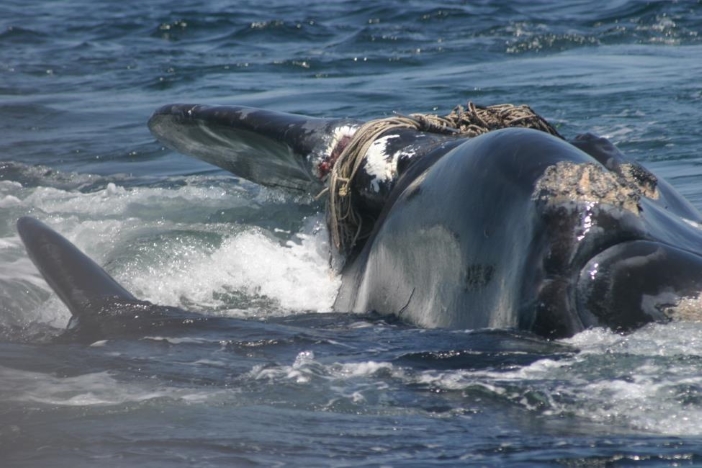
Kingfisher with severe tissue damage on his flipper from the rope
Photo credit: Northeast Fisheries Science Center
Preventing entanglements from happening in the first place is the key to stopping this suffering and potential extinction of the species. The rope that attaches buoys to lobster and crab traps is the biggest threat these whales face. Rope didn't used to be as strong as it is now but almost all most rope used by the fishing industry is currently made of extremely strong materials like polypropylene. The stronger the rope, the worse it is for whales though. One recent study examined both live and dead North Atlantic right whales and humpback whales who were entangled from 1994 to 2010 and tested 132 ropes from 70 different cases and in all of those cases the rope was synthetic. Most were polyropylene or other combinations of synthetic plastics, some with lead added,18 and according to the study, "For right whales, severity of injuries increased since the mid 1980s, possibly due to changes in rope manufacturing in the mid 1990s that resulted in production of stronger ropes at the same diameter."19
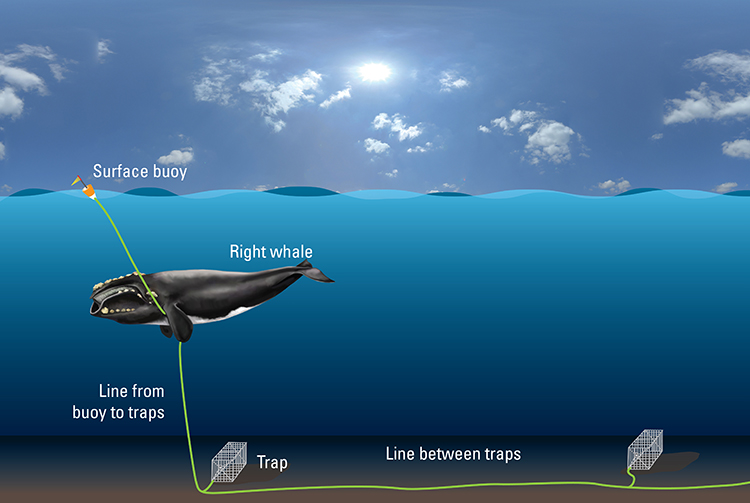
Rope is an unnatural addition to North Atlantic right whale habitat and is a major threat to their survival
Illustration Credit: Graphic Services, Woods Hole Oceanographic Institution
These whales are swimming through a minefield of increasingly strong ropes and nets as they simply move around their habitat and try to get to their feeding and calving grounds. Some regulations have been put in place over the years but many, such as those in Massachusetts, only regulate abandoned gear and temporarily close certain areas to fishing.21 We support these efforts and believe they are better than nothing but as stated by the Marine Mammal Commission, an independent government agency, "right whale deaths attributed to fishing gear have increased substantially since rulemaking efforts began in 1997."22

A male North Atlantic right whale (Catalog #1238) found dead near the Magdalen Islands, Quebec, Canada on October 29, 2001, entangled in over 650 feet of lead filament rope.
Photo credit: Lethal entanglement in baleen whales20
There has also been much talk over the years of modifications to fishing gear in an attempt to lessen the risk of deadly entanglements, such as ropes with weak links that whales could theoretically break. At the very least, the rope would have to be entangling them a certain way for the whale to break it. This type of rope hasn't been extensively tested in the wild and these whales don't have the time for us to finally get it right, if that can ever be done, and the idea that they would work at all is still only a theory. There is also more talk of ropeless fishing gear and some researchers are currently working on this.23 While we are generally supportive of their efforts, new technology takes time to introduce and it's meeting opposition from the lobster industry who claim that better technology would be too expensive.24
The profit margin is unfortunately the main thing the industry cares about and with safer fishing gear being more expensive and different than what they're used to using, hardly anyone is using it voluntarily.25 If the industry cared about these whales and wanted to prevent their deaths then the supposedly safer gear would already be in use on a wide scale and we would at least see if it made any difference. There's the option of requiring fishermen to use this new gear that's (theoretically) safer but that takes either legislation or new regulations and we see that as unlikely at this point in time.
"The real answer was off the table. Regulators had decided it wasn’t feasible to get rope out of the water column. There was no way they could prohibit lobstering, not in New England. And they had ruled that gear that could free the ocean from ropes — buoys stored on the ocean floor until released by a timer or acoustic signal — was impractical." - Chasing Bayla, Boston Globe
In light of the large amount of deaths in the Gulf of St. Lawrence in 2017 there have been claims that regulations weren't in place there because fishermen and the Canadian government didn't know whales would be there.26 This isn't true as North Atlantic right whales have been spotted in the Gulf of St. Lawrence for years, their dire situation has also been known for years and in 2016 there was at least one entanglement death and one other severe entanglement involving snow crab gear. One whale washed up dead on Sable Island off the coast of Nova Scotia wrapped in rope27 and a couple of weeks later a well-known whale named FDR (Catalog #4057) was found with a severe entanglement in the Bay of Fundy and was thankfully freed after a lengthy rescue operation by the Campobello Whale Rescue Team.28 He was carrying a large amount of thick ropes that were cutting into his flesh, right over some scars that he had received two years earlier at the age of four from an entanglement of over 300 feet of lead-weighted, 11/16 diameter rope.29 The rope from the Sable Island whale and FDR's 2016 entanglement was traced back to Shippagan, New Brunswick30 - the same area where many of the deaths and entanglements in 2017 occurred.31 The government was warned about a possible rise in sightings of North Atlantic right whales, and a possible rise in injuries or deaths, in the Gulf of St. Lawrence back in 2016 and nothing was done.
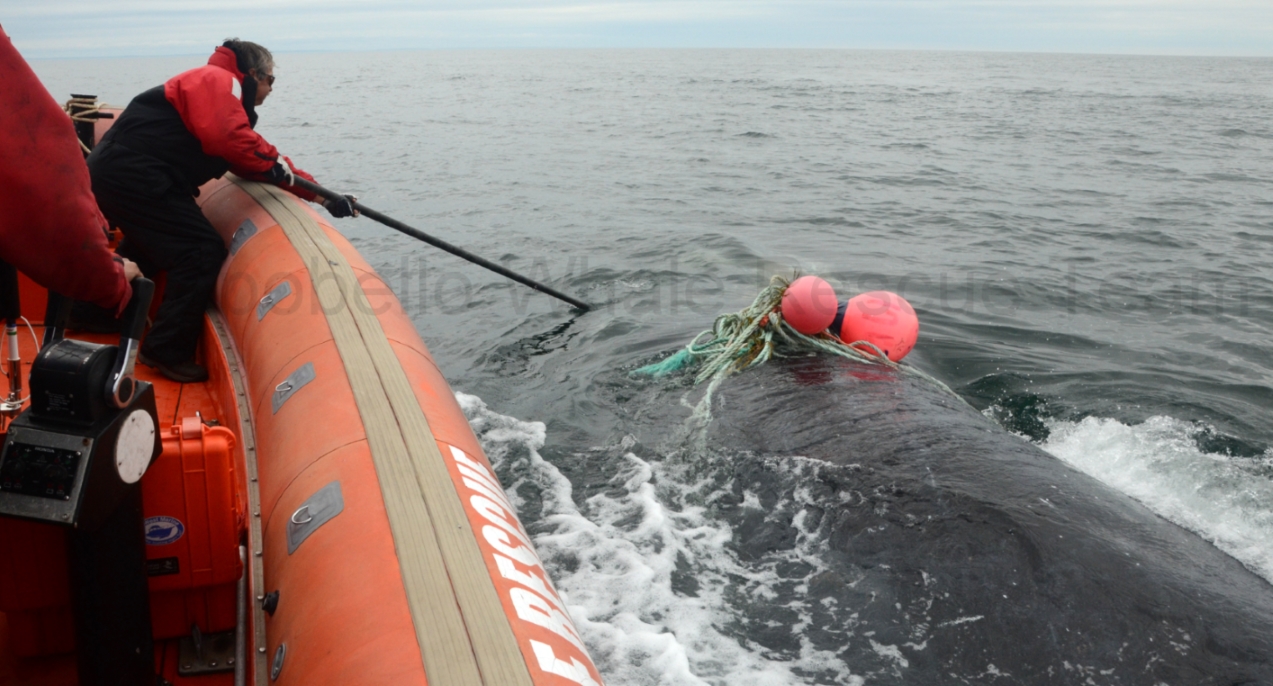
Joe Howlett making a cut to the rope entangling FDR in August of 2016.
Photo credit: Campobello Whale Rescue Team/CWI
In July of 2017 alone, there were two whales that were successfully disentangled from snow crab gear in an area near Shippagan, New Brunswick. The first whale was rescued on July 5th and the second on July 10th.32 The second disentanglement ended in tragedy when one of the rescuers - Joe Howlett, co-founder of the Campobello Whale Rescue Team - was killed after making the last cut on the rope when the whale made a sudden movement and struck him.33 He saved many whales over the years, including FDR in 2016, and his contributions to the battle to save these whales from suffering and extinction must never be forgotten.
Under the Endangered Species Act, North Atlantic right whales have a Potential Biological Removal (PBR) number of 1.34 This means that just one whale taken from the population by humans could have a negative effect on the long term viability of the population. Just one death should spur serious action and lead to more regulations yet it didn't until at least 17 whales were killed with at least another 10 entangled. That's at least 6% of the entire population that was killed or entangled and it's believed that we may see as little as 1 out of 3 deaths.35
The fact is, North Atlantic right whales have been under attack for decades with generation after generation bearing the scars and the loss of life from this constant assault on their species. There's a well-known North Atlantic right whale named Wart (Catalog #1140) who was first spotted in 1981 and is believed to be in her 50's now. She has suffered through at least two entanglements36 but has thankfully kept pushing forward and so far she has had 7 calves, is grandmother to 13 and great-grandmother to 6. Of her descendents, every one of her seven calves has scars from fishing lines. Three also have been hit by ships, and one is presumed dead. Of the 13 grand-calves, 12 have entanglement scars, 15% show ship-strike scars and 2 are presumed dead. Half of Wart’s third generation of calves show signs of entanglement, one has been hit by a ship, and two are presumed dead.37 This is just one example of many where entire families of North Atlantic right whales have been profoundly affected by human activity.
The NOAA is mandated to consider the well-being of the fishing industry in their actions but as a group of concerned citizens we are not constrained by such a mandate. The truth is that the fishing industry is leading the North Atlantic right whale to extinction and causing massive suffering along the way.38 We do not believe that new technology in fishing gear can fully resolve the issue of whales becoming entangled. Even if it somehow could, the invention of such technology and the implementation of it is uncertain as it faces opposition from the industry and could arrive too late - especially for highly endangered species like the North Atlantic right whale.
"Moore believed the regulators could have been bolder had NOAA not also been mandated to consider the economic well-being of industries like fishing that rely on the ocean. Regulators’ intentions were good. They committed generous funding to researchers studying entanglement. But Moore felt that regulators ultimately were handicapped by having to serve the conflicting interests of whales and fishermen." - Chasing Bayla, Boston Globe
While we still support the efforts to make fishing gear safer for whales, it's become clear that avoiding any seafood caught in traps or gillnets is the best way to help these whales from becoming injured and killed by fishing gear. Unfortunately when we buy things like lobster, snow crab and various types of fish we are creating demand for continued, and increased, use of fishing gear that is deadly to whales. Since supply and demand is the system that the fishing industry responds to, less consumption means less traps and will start to add up as more of us avoid eating anything caught in traps or gillnets. When we are used to something, especially a food we enjoy eating, it can be tough to change and tough to hear certain things about how it's produced but the evidence is unfortunately clear; the ropes, traps and gillnets used to catch seafood are deadly to whales and cause them significant amounts of pain and suffering.3940
We believe that this boycott of seafood is similar to other issues, for example, the use of sweatshops in the manufacturing of clothing. When many of us learn of sweatshops being used by clothing brands that we like then we look to change our buying patterns to avoid those brands. The fact that sometimes we don't know of these types of things going on is understandable. It's also understandable that many people haven't yet heard of what is happening to these whales as most media coverage doesn't quite have all the details that we have on this page. This is why we started this project, to provide a resource where the facts about the threats that North Atlantic right whales face are laid out clearly so that everyone who visits our site can use this information in their future decision-making.
We are not going to just watch these whales suffer and go extinct and since you just read this entire page we know you feel the same way. Even though change on a scale this big takes time, by avoiding seafood we can be sure that our eating choices are no longer contributing to the deaths of these whales and other species of whales that are killed by fishing gear. Every single one of us that takes this action brings us closer to a day when North Atlantic right whales are safe from human activity and can live in peace.
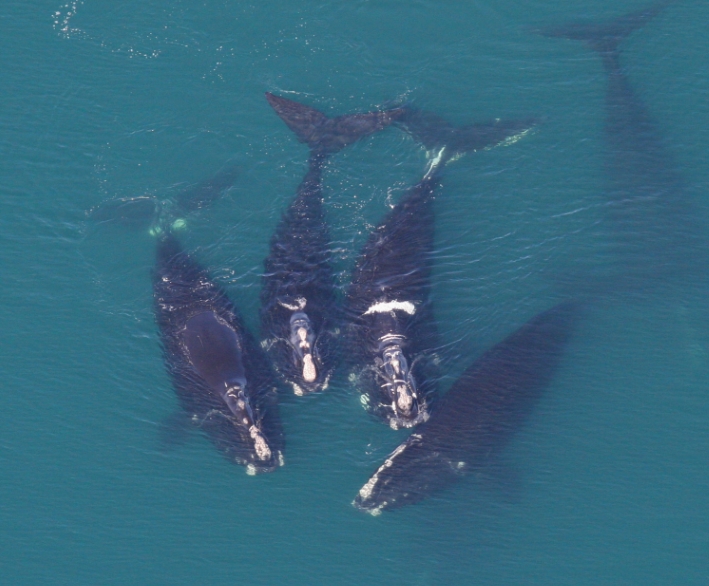
Four right whales socializing near Charleston, South Carolina on February 01, 2012. Ruffian (Catalog #3530, second from the right) has extensive scars from an entanglement in fishing gear that he suffered in 2008. He was recently seen in waters near Florida in January of 2017 with another entanglement and thankfully he was freed by a team of biologists from Florida and Georgia. They removed 450 feet of rope and a 135 pound trap that he was dragging behind him - here is a YouTube video made by the Georgia Department of Natural Resources about his rescue.
Photo credit: Sea to Shore Alliance/NOAA, NOAA permit #15488 - full size photo
Sources:
1Endangered right whale population threatened by entanglements and dramatically declining birth rate - https://www.sciencedaily.com/releases/2016/09/160901092829.htm - back to paragraph
2Monitoring North Atlantic right whale Eubalaena glacialis entanglement rates: a 30 yr retrospective - page 294 - http://www.int-res.com/articles/meps_oa/m466p293.pdf - back to paragraph
3NOAA - Fishing Gear: Traps and Pots - https://www.fisheries.noaa.gov/national/bycatch/fishing-gear-traps-and-pots - back to paragraph
4NOAA - Fishing Gear: Gillnets - https://www.fisheries.noaa.gov/national/bycatch/fishing-gear-gillnets - back to paragraph
5Monitoring North Atlantic right whale Eubalaena glacialis entanglement rates: a 30 yr retrospective - page 1 - Introduction - http://www.int-res.com/articles/meps_oa/m466p293.pdf - back to paragraph
6Lethal entanglement in baleen whales - page 178 - http://www.int-res.com/articles/feature/d096p175.pdf - back to paragraph
7Lethal entanglement in baleen whales - page 177 -
http://www.int-res.com/articles/feature/d096p175.pdf - back to paragraph
8CCS Whale Rescue FAQ - http://coastalstudies.org/whale-rescue/faq/ - back to paragraph
9CCS Disentanglement Updates - http://coastalstudies.org/whale-rescue/disentanglement-updates/ - back to paragraph
10A Tragic End for a Favorite Whale, Snowball - New England Aquarium Right Whale Research Blog - http://rightwhales.neaq.org/2015/03/a-tragic-end-for-favorite-whale-snowball.html - back to paragraph
11North Atlantic Right Whale Consortium 2014 Annual Report Card - https://www.narwc.org/uploads/1/1/6/6/116623219/2014_report_card.pdf - back to paragraph
12North Atlantic Right Whale Consortium 2015 Annual Report Card - https://www.narwc.org/uploads/1/1/6/6/116623219/2015_report_card.pdf
- back to paragraph
13Lethal entanglement in baleen whales - page 177 - http://www.int-res.com/articles/feature/d096p175.pdf - back to paragraph
14Center for Coastal Studies Facebook post - 12-18-2016 - https://www.facebook.com/coastalstudies/posts/10154807237657436 - back to paragraph
15Center for Coastal Studies Facebook post - 12-21-2016 - https://www.facebook.com/coastalstudies/posts/10154816811567436:0 - back to paragraph
16North Atlantic Right Whale Consortium 2017 Annual Report Card - page 9 - https://www.narwc.org/uploads/1/1/6/6/116623219/2017_report_cardfinal.pdf - back to paragraph
17Kingfisher the Entangled Right Whale Re-sighted off the Georgia Coast - http://www.noaanews.noaa.gov/stories2005/s2368.htm - back to paragraph
18Effects of fishing rope strength on the severity of large whale entanglements - Table 1 -
http://onlinelibrary.wiley.com/doi/10.1111/cobi.12590/full - back to paragraph
19Effects of fishing rope strength on the severity of large whale entanglements -
http://onlinelibrary.wiley.com/doi/10.1111/cobi.12590/abstract - back to paragraph
20Supplement to 'Lethal entanglement in baleen whales study - page 19 - http://www.int-res.com/articles/suppl/d096p175_supp.pdf - back to paragraph
21Massachusetts Whale-Related Gear Rules - http://www.eregulations.com/massachusetts/fishing/saltwater/whale-gear-restrictions-closures/ - back to paragraph
22Marine Mammal Commision: Right Whales and Entanglement in Fishing Gear - https://www.mmc.gov/priority-topics/species-of-concern/north-atlantic-right-whale/entanglement-in-fishing-gear/ - back to paragraph
23Ropeless traps could help mitigate right whale deaths - CBC article - http://www.cbc.ca/news/canada/prince-edward-island/pei-scientist-ropeless-traps-right-whales-1.4465276 - back to paragraph
24 These whales will be extinct in 25 years, scientists say — unless we act now to save them - Washington Post - https://www.washingtonpost.com/national/health-science/these-whales-will-be-extinct-in-25-years-scientists-say--unless-we-act-now-to-save-them/2018/04/20/57bf89b2-4320-11e8-8569-26fda6b404c7_story.html
- back to paragraph
25To protect right whales, scientists propose major changes for lobstermen - Boston Globe - https://www.bostonglobe.com/metro/2018/02/19/protect-right-whales-scientists-propose-major-changes-for-lobstermen/wkfsxrDPWJNtBLmPZNlUOJ/story.html - back to paragraph
26No Sign of Newborn North Atlantic Right Whales This Breeding Season - https://www.nytimes.com/2018/02/28/science/north-atlantic-whales -endangered.html - back to paragraph
27North Atlantic Right Whale News - January 2017 - page 3 - https://www.narwc.org/uploads/1/1/6/6/116623219/rwn-jan17.pdf -
back to paragraph
28Campbello Team Rescues Right Whale 'FDR' - http://www.andersoncabotcenterforoceanlife.org/blog/campobello-team-rescues-right-whale-fdr/ - back to paragraph
29Biologists Free Whale From Fishing Gear Off Georgia Coast - http://www.huffingtonpost.com/2014/02/23/whale-freed-fishing-gear_n_4832946.html
- back to paragraph
30North Atlantic Right Whale - Threats and mitigation in Canadian waters - page 13 - https://www.mmc.gov/wp-content/uploads/Buie_MMC-presentation-final.pdf - back to paragraph
31Interview with North Atlantic Right Whale Expert -
https://www.discovery.ca/Shows/Daily-Planet/Articles/Q-A-with-North-Atlantic-right-whale-expert - back to paragraph
32Right whale freed from fishing gear in Gulf of St. Lawrence north of P.E.I. - http://www.cbc.ca/news/canada/nova-scotia/right-whale-entangled-in-fishing-gear-1.4192514 - back to paragraph
33Fisherman who died saving whale saw rescue as a duty - http://www.cbc.ca/news/canada/new-brunswick/whale-campobello-island-joe-howlett-1.4199027 - back to paragraph
34NOAA Fisheries Service North Atlantic Right Whale 5-Year Review, August 2017 - page 17 - https://www.greateratlantic.fisheries.noaa.gov/protected/final_narw_5-year_review_2017.pdf - back to paragraph
35No Sign of Newborn North Atlantic Whales This Breeding Season - https://www.nytimes.com/2018/02/28/science/north-atlantic-whales-endangered.html - back to paragraph
36Special Report: North Atlantic Right Whales in Crisis - Cape Cod Times - http://www.capecodtimes.com/news/20180324/special-report-north-atlantic-right-whales-in-crisis - back to paragraph
37Special Report: North Atlantic Right Whales in Crisis - Cape Cod Times - Wart family tree graphic - http://static.djlmgdigital.com/cct/capecodonline/special/whales/wartgraphic.pdf
- back to paragraph
38Assessment of Management to Mitigate Anthropogenic Effects on Large Whales - Table 2 - http://onlinelibrary.wiley.com/doi/10.1111/j.1523-1739.2012.01934.x/full - back to paragraph
39Lethal entanglement in baleen whales - http://www.int-res.com/articles/feature/d096p175.pdf - back to paragraph
40Lethal entanglement in baleen whales - Supplement - Detailed case histories for all 21 whales examined in the study http://www.int-res.com/articles/suppl/d096p175_supp.pdf - back to paragraph